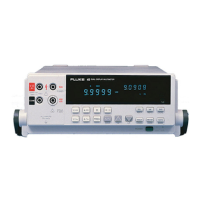Diagnostic Testing and Troubleshooting
Calibration Failures
5
5-21
calibration step. Table 5-7 provides a different approach, relating components that are
common to a group of calibration steps.
5-19. Calibration Interrelationships
If you suspect calibration errors, but the meter does not exhibit the symptoms mentioned
above, verify that you are observing the following calibration rules:
• Stored dc volts calibration constants influence constants for several other functions.
If dc volts is recalibrated, these other functions must be recalibrated. This
interrelationship is explained in Table 5-8.
• Independent calibration of any function except dc volts results in the storage of
correcting calibration constants for that function only.
• Once calibration is begun, all steps for that function must be completed before the
calibration constants are stored. If all steps are not completed and the procedure is
terminated, only calibration constants for previously completed functions are stored.
5-20. Retrieving Calibration Constants
If a calibration error is suspected, the stored constant can be retrieved and verified over
the computer interface. This information can be specified by the number of the constant.
Table 5-9 lists the calibration constant numbers. Use the following format:
CALCONST? xx (where xx denotes the calibration constant number)
Except for constants 9, 11, 21, and 32, the response format is:
±1.XXXXXXor ±0.XXXXXXX
5-21. Replacing the EEROM A1U5
The EEROM provides non-volatile storage for the serial number of the meter, meter
configuration and calibration information. If the EEROM is replaced during repair, the
new EEROM should be programmed with the 7-digit serial number, found on the rear
panel of the meter. Use the following command to program the serial number into the
EEROM:
SERIAL XXXXXXX (xxxxxxx denotes the 7-digit serial number. Note:
once entered, the serial number cannot be changed.)

